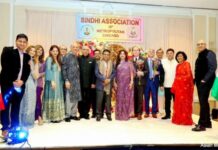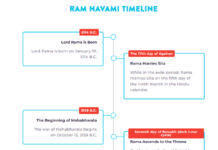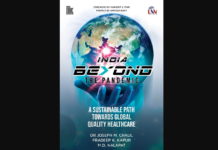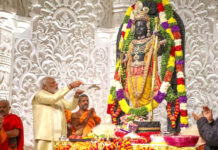
ELIZABETH CHALIER
CHICAG: Visiting Dutch professor Peter van der Veer, current occupant of the University of Chicago (UC) Vivekananda Chair, delivered his official public address titled “The Modern Spirit of Asia: Comparing Indian and Chinese Spiritual Nationalism” May 7 at THE UC Social Sciences building.
He started off by pointing out that the yoga popularized by Swami Vivekananda (SV) in America – through a process of “abstraction and purification” – had little in common with such traditions and had constituted, even at the time of its ancient founder Patanjali, only a small fraction of the vast disparate landscape of what now passes as ‘Hinduism’.
He attributed such ‘standardization’ of complex Asian spiritualities to the unifying nationalist impulse awakened in response to Western colonial domination, discernible also in Pung Kwangyu and Anagarika Dharmapala, Chinese and (Theravada) Buddhist delegates respectively to the 1893 World Parliament of Religions (WPR). Such separatist ‘nationalization’ of precolonial modes of lived spirituality led to India’s Partition.
Swami Vivekananda ’s spectacular intervention here in Chicago was “world-historical” also by reformulating traditional Hinduism int oa new “cosmopolitan” spirituality led by a universalizing India, van der Veer said. Yoga, as “India’s gift to the world,” however, could have been invented only in modern America. The same would be true even of “spiritualism”, which “connects English antinomianism with a new anticolonial universalism”, exemplified by Madame Blavatsky and especially Annie Besant, the first female and feminist president of the Indian National Congress.
Their anti-Church activism sought to replace authoritarian faith with an embodied spirituality focused on accessible techniques of self-mastery, the professor said. Though SV distanced himself from these theosophists, van der Veer bracketed them together as espousing the scientific spirit allied with a higher intuition against the claims of modern ‘secular’ rationalism. Such an esoteric worldview found its most powerful expression through the modern abstractions of visual art (Kadinsky, Mondrian).
In India, however, this cosmopolitanism was infused with nationalism, as in the Bengal school of art, van der Veer said. Through Ananda K, Coomaraswamy, Tagore, Gandhi, even Nehru, and their counterparts elsewhere, widespread anticolonial sentiment translated into a pan-Asianism as a middle ground that opposed the shared civilizational ethos of the East to the hegemony of a West embroiled in the savagery of World War I. The fountainhead of their anglophone affirmation of colonized India as “the spiritual leader of the world” accepted by Western intellectuals and avantgarde artists remains SV.
However, Asian nations such as China and Japan harbored caveats, misgivings, and eventual rejection regarding this claim facilitated by ‘Indo-European’ scholarship, accrding to van der Veer. At WPR, Pung Kwangyu’s stance was diametrically opposed to SV’s insistence on universal toleration based on recognizing all religions as equal. Elevating Confucianist “teaching” above “religion”, some among which amount to “dangerous superstition,” he defended their subordination to the mandate of the Manchu state.
Contemporary ‘reformism’ in China campaigned in vain for the destruction of temples to be replaced with national schools to teach Western science alongside Confucian ethics, thereby deviating from the vital role of ritual in maintaining institutional orthodoxy, including that of the imperial state. “Moral nationalism” was expressed instead through movements inspired by spirit-possession and spirit-rising, influenced by Christianity, that fueled millenarian political revolt against (Manchu) state authority as in the Taiping, later Boxer rebellions, and hence themore recent suppression of Falun Gong by the Communist Party.
Comments followed interrogating various threads of van der Veer’s overall argument. UC Tibetan Buddhism professor Matthew Kapstein contrasted the early political and linguistic unification of Chinese civilization with India’s fragmented socio-religious history to further debunk the chimera of a ‘pan-Asian’ spirituality.
Sunthar Visuvalingam countered that such radical difference would have instead served as powerful poles of attraction between China and India (Tan Chung) as prime movers of the continent’strajectory. He cited the Qianlong Emperor (1711-99), who had thoroughly assimilated Confucian values while conserving his shamanistic Manchu heritage. Covered with Sanskrit inscriptions, the tomb of this devout Buddhist, who took the Dalai Lama for mentor, attests to precolonial India being Asia’s spiritual leader. SV’s ‘ecumenism’ at WPR would be the postcolonial extension of the cosmopolitan worldview inherent in traditional Sanskritic culture as demonstratedby Sheldon Pollock (formerly UC professor).
Van der Veer clarified that his own focus is the transformative effect of the imperial encounter that not only pits modern Asian ‘nation-states” against each other but now threatens to break India apart through the rise of separatist ethno-nationalisms. He lamented how this Westward gaze had disrupted the symbiotic relationship emerging across the subcontinent between Sufi and Hindu spiritualities. Given that such nation-forming is “historically contingent and fragmented,” while the force unleashed in Chicago by SV “derives its social energy from an unfinished project,” there seems still reason for hope, he said.






